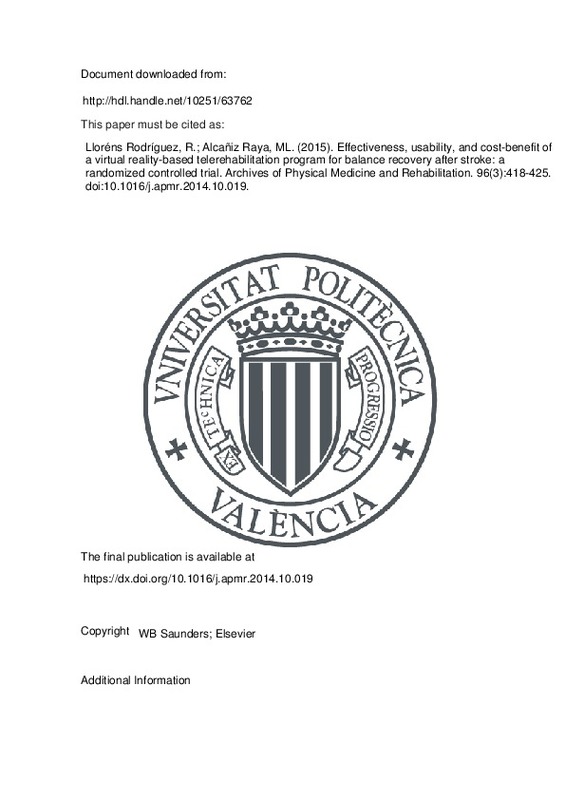JavaScript is disabled for your browser. Some features of this site may not work without it.
Buscar en RiuNet
Listar
Mi cuenta
Estadísticas
Ayuda RiuNet
Admin. UPV
Effectiveness, usability, and cost-benefit of a virtual reality-based telerehabilitation program for balance recovery after stroke: a randomized controlled trial
Mostrar el registro sencillo del ítem
Ficheros en el ítem
| dc.contributor.author | Llorens Rodríguez, Roberto
|
es_ES |
| dc.contributor.author | Noe, Enrique
|
es_ES |
| dc.contributor.author | Colomer, Carolina
|
|
| dc.contributor.author | Alcañiz Raya, Mariano Luis
|
|
| dc.date.accessioned | 2016-05-09T06:53:18Z | |
| dc.date.available | 2016-05-09T06:53:18Z | |
| dc.date.issued | 2015-03 | |
| dc.identifier.issn | 0003-9993 | |
| dc.identifier.uri | http://hdl.handle.net/10251/63762 | |
| dc.description.abstract | [EN] Objectives: First, to evaluate the clinical effectiveness of a virtual reality (VR) based telerehabilitation program in the balance recovery of individuals with hemiparesis after stroke in comparison with an in-clinic program; second, to compare the subjective experiences; and third, to contrast the costs of both programs. Design: Single-blind, randomized, controlled trial. Setting: Neurorehabilitation unit. Participants: Chronic outpatients with stroke (N=30) with residual hemiparesis. Interventions: Twenty 45-minute training sessions with the telerehabilitation system, conducted 3 times a week, in the clinic or in the home. Main Outcome Measures: First, Berg Balance Scale for balance assessment. The Performance-Oriented Mobility Assessment balance and gait sub-scales, and the Brunel Balance Assessment were secondary outcome measures. Clinical assessments were conducted at baseline, 8 weeks (posttreatment), and 12 weeks (follow-up). Second, the System Usability Scale and the Intrinsic Motivation Inventory for subjective experiences. Third, cost (in dollars). Results: Significant improvement in both groups (in-clinic group [control] and a home-based telerehabilitation group) from the initial to the final assessment in the Berg Balance Scale (eta(2)(p) = .68; P=.001), in the balance (eta(2)(p) = .24; P=.006) and gait (eta(2)(p) =.57, P=.001) subscales of the Tinetti Performance-Oriented Mobility Assessment, and in the Brunel Balance Assessment (control: chi(2)=15.0; P=.002; experimental: chi(2)=21.9; P=.001). No significant differences were found between the groups in any balance scale or in the feedback questionnaires. With regard to subjective experiences, both groups considered the VR system similarly usable and motivating. The in-clinic intervention resulted in more expenses than did the telerehabilitation intervention ($654.72 per person). Conclusions: First, VR-based telerehabilitation interventions can promote the reacquisition of locomotor skills associated with balance in the same way as do in-clinic interventions, both complemented with a conventional therapy program; second, the usability of and motivation to use the 2 interventions can be similar; and third, telerehabilitation interventions can involve savings that vary depending on each scenario. (C) 2015 by the American Congress of Rehabilitation Medicine | es_ES |
| dc.description.sponsorship | Supported in part by the Ministry of Economy and Competitiveness, Project TEREHA (IDI-20110844) and by the Ministry of Education and Science, projects Consolider-C (SET2006-14301/PSIC), "CLBER of Physiopathology of Obesity and Nutrition, an initiative of ISCHI," and the Excellence Research Program PROMETEO (Generalitat Valenciana, Conselleria de Educacion, 2008-157). | en_EN |
| dc.language | Inglés | es_ES |
| dc.publisher | WB Saunders | es_ES |
| dc.publisher | Elsevier | es_ES |
| dc.relation.ispartof | Archives of Physical Medicine and Rehabilitation | es_ES |
| dc.rights | Reserva de todos los derechos | es_ES |
| dc.subject | Cost comparison | es_ES |
| dc.subject | Postural balance | es_ES |
| dc.subject | Rehabilitation | es_ES |
| dc.subject | Stroke | es_ES |
| dc.subject | Virtual reality therapy | es_ES |
| dc.subject.classification | EXPRESION GRAFICA EN LA INGENIERIA | es_ES |
| dc.title | Effectiveness, usability, and cost-benefit of a virtual reality-based telerehabilitation program for balance recovery after stroke: a randomized controlled trial | es_ES |
| dc.type | Artículo | es_ES |
| dc.identifier.doi | 10.1016/j.apmr.2014.10.019 | |
| dc.relation.projectID | info:eu-repo/grantAgreement/MICINN//IDI-20110844/ES/PLATAFORMA INTEGRAL DE TELERREHABILITACIÓN MOTORA, COGNITIVA Y PSICOSOCIAL, MEDIANTE EL USO DE TECNOLOGÍAS TIC E INTERFACES NATURALES (TEREHA) (3%2F5)/ | es_ES |
| dc.relation.projectID | info:eu-repo/grantAgreement/MEC//SEJ2006-14301/ES/NUEVAS TECNOLOGIAS DE LA INFORMACION Y LA COMUNICACION: INTEGRACION Y CONSOLIDACION DE SU USO EN CIENCIAS SOCIALES PARA MEJORAR LA SALUD, LA CALIDAD DE VIDA Y EL BIENESTAR/ | es_ES |
| dc.relation.projectID | info:eu-repo/grantAgreement/GVA//PROMETEO08%2F2008%2F157/ES/Promoción del bienestar a través de las tecnologías de la información y comunicación (probientic)/ | es_ES |
| dc.rights.accessRights | Abierto | es_ES |
| dc.contributor.affiliation | Universitat Politècnica de València. Instituto Interuniversitario de Investigación en Bioingeniería y Tecnología Orientada al Ser Humano - Institut Interuniversitari d'Investigació en Bioenginyeria i Tecnologia Orientada a l'Ésser Humà | es_ES |
| dc.contributor.affiliation | Universitat Politècnica de València. Departamento de Ingeniería Gráfica - Departament d'Enginyeria Gràfica | es_ES |
| dc.description.bibliographicCitation | Llorens Rodríguez, R.; Noe, E.; Colomer, C.; Alcañiz Raya, ML. (2015). Effectiveness, usability, and cost-benefit of a virtual reality-based telerehabilitation program for balance recovery after stroke: a randomized controlled trial. Archives of Physical Medicine and Rehabilitation. 96(3):418-425. https://doi.org/10.1016/j.apmr.2014.10.019 | es_ES |
| dc.description.accrualMethod | S | es_ES |
| dc.relation.publisherversion | https://dx.doi.org/10.1016/j.apmr.2014.10.019 | es_ES |
| dc.description.upvformatpinicio | 418 | es_ES |
| dc.description.upvformatpfin | 425 | es_ES |
| dc.type.version | info:eu-repo/semantics/publishedVersion | es_ES |
| dc.description.volume | 96 | es_ES |
| dc.description.issue | 3 | es_ES |
| dc.relation.senia | 283529 | es_ES |
| dc.identifier.eissn | 1532-821X | |
| dc.contributor.funder | Ministerio de Ciencia e Innovación | es_ES |
| dc.contributor.funder | Generalitat Valenciana | es_ES |
| dc.contributor.funder | Ministerio de Educación y Ciencia | es_ES |
| dc.contributor.funder | Centro de Investigación Biomédica en Red-Fisiopatología de la Obesidad y Nutrición | es_ES |







![[Cerrado]](/themes/UPV/images/candado.png)

